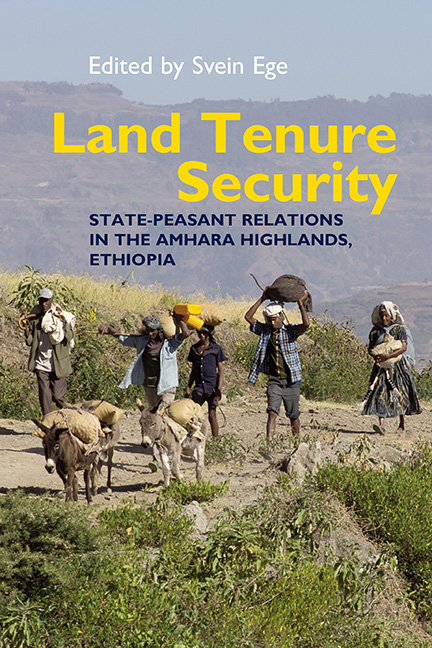Book contents
- Frontmatter
- Dedication
- Contents
- List of Illustrations
- Note on Transliteration
- Dates and Measures
- Contributors
- Preface
- Glossary
- Map
- 1 Introduction
- 2 Peasant Land Tenure: A Critical Review
- 3 The Dersha System: Rethinking Land Tenure under the Därg
- 4 Land Tenure in Gojam under the Därg
- 5 Land Tenure in Baba Säat, North Wälo
- 6 Rich and Poor: Land and Wealth in Mäqét, North Wälo
- 7 Rural Land and Urban Aspirations: Future Orientation in a Time of Change
- 8 An Unstable Land Tenure System
- 9 Conclusion
- Postface
- Select Bibliography
- Index
- Eastern African Studies
4 - Land Tenure in Gojam under the Därg
Published online by Cambridge University Press: 26 March 2019
- Frontmatter
- Dedication
- Contents
- List of Illustrations
- Note on Transliteration
- Dates and Measures
- Contributors
- Preface
- Glossary
- Map
- 1 Introduction
- 2 Peasant Land Tenure: A Critical Review
- 3 The Dersha System: Rethinking Land Tenure under the Därg
- 4 Land Tenure in Gojam under the Därg
- 5 Land Tenure in Baba Säat, North Wälo
- 6 Rich and Poor: Land and Wealth in Mäqét, North Wälo
- 7 Rural Land and Urban Aspirations: Future Orientation in a Time of Change
- 8 An Unstable Land Tenure System
- 9 Conclusion
- Postface
- Select Bibliography
- Index
- Eastern African Studies
Summary
The 1975 land reform was a revolution in land tenure and social relations. The literature on this reform is mainly either a restatement of the proclamation of 1975 (Ethiopian Government 1975) or it presents the image of frequent land redistributions upsetting peasant tenure security – in both cases without much information about what happened on the ground. In the previous chapter, Ege outlined the dersha theory of peasant land tenure based on the process in Ayné. In this chapter, we show how this also fits a community with a rather different pre-reform land tenure system, Dinja S'iyon in Gojam. We also build on the contribution of Yeraswork, who distinguished between land reallocations aimed to improve equity in landholdings and those which sought to transform peasant society by policies such as producer cooperatives or villagization.
EVIDENCE OF REDISTRIBUTION
‘Redistribution’ is a frustratingly imprecise term. It may cover various local terms, such as kefefel (division), deledel (levelling down) or shegesheg, and sometimes it is also used for household processes such as giving land to a son (gulma). Furthermore, the causes of redistributions were varied. A study by the Ministry of Agriculture (MoA 1989) shows that causes of reallocation included the formation of producer cooperatives, villagization, afforestation projects, state farms, establishment of different institutions and projects, expansion of towns and sites for schools – as well as accommodating emerging households. The handling of the last element, in the form of periodic land redistribution, has dominated our understanding of the land tenure system under the Därg. However, closer examination shows that accommodating new households was only one of the causes of land reallocation. In addition, it was mainly a corollary of other important concerns.
In Chapter 3, Ege distinguished between comprehensive redistributions for improved equity and various kinds of specific-purpose redistribution, which he referred to as reallocations. A similar distinction can be culled from Yeraswork's (2000) study of sites in Wälo and North Shäwa, in which he classified redistributions as minor or major. ‘All land redistribution drives affecting a sizable number of member households were presumed major redistributions, whereas those affecting only a small number of people were considered minor ones’ (Yeraswork 2000: 194).
- Type
- Chapter
- Information
- Land Tenure SecurityState-peasant relations in the Amhara Highlands, Ethiopia, pp. 68 - 79Publisher: Boydell & BrewerPrint publication year: 2019



